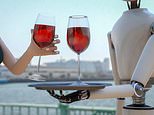
Scientists analysed the components of 80 red wines from seven wine estatesAI was able to identify the origina and year of each with 100% accuracy
Wine sommeliers are experts in their field, able to help decipher wine lists and recommend which bottles complement certain foods.
But they could be facing competition from somm-AI-liers, according to a new study.
Experts from the University of Bordeaux say that artificial intelligence (AI) can detect the chemical profiles in wine with remarkable accuracy.
During testing, AI was able to identify the origin and vintage of different varieties with 100 per cent accuracy.
The researchers now plan to put the bot head-to-head against a human sommelier to see how the two stack up.
Robots could soon help you pick your wine, as a study reveals AI can identify the origin and vintage of plonk with 100% accuracy (stock image)
In the study, the researchers used gas chromatography – a technique used to separate and identify components within a mixture – to analyse the chemical composition of 80 red wines across seven wine estates in the Bordeaux region of France.
They looked at 12 harvest years, between 1990 and 2007.
The team then used machine learning algorithms to look at the raw, unprocessed results of the analysis, and to group the wines into clusters based on the similarity of their chemical compositions.
The authors found that their technique could group wines into clusters according to their estate with 100 per cent accuracy and according to their vintage with up to 50 per cent accuracy.
Writing in the journal Communications Chemistry the scientists, from the University of Bordeaux, said: ‘It would be interesting to compare the performance of our model to the one of expert human tasters on blind tasting of the 80 wines we have analysed.
In the study, the researchers used gas chromatography – a technique used to separate and identify components within a mixture – to analyse the chemical composition of 80 red wines across seven wine estates in the Bordeaux region of France (stock image)
‘Whether expert wine tasters would be able to match our model’s performance – 100 per cent – on these seven estates is not known.
‘Given our strong performance with estate recognition, artificial…systems might be able to complement human tasters on wine recognition.’
Bordeaux, in the southwest of France, is the home of Merlot and Cabernet Sauvignon.
Red wine from the region typically has aromas of red berries, blackcurrant and ‘earthiness’, with the taste described as supple and fruity.
Experts say red Bordeaux is best served just slightly below room temperature, at around 18C (65F), and is best paired with steak and chips.
WHAT’S THE BEST WAY TO TASTE WINE PROPERLY?
When it comes to drinking wine, there a few things that can make all the difference.
Australian wine-connoisseur Caitlyn Rees offers how to taste wines like an expert
Step 1: See
Before you even down that first sip, you first need to take a look at the wine in your glass.
‘See refers to the appearance of the wine. This is where you can check the clarity, intensity and colour.
‘If the wine is hazy it could be faulty but more likely unfiltered.’
Step 2: Swirl
You’ve probably seen wine drinkers swirl the wine in their glass before taking a sip.
The reason is to allowed the wine to ‘open up’ and reveal the maximum amount of aroma, flavour and intensity.
‘Swirling releases the aroma particles that make the next step, smell, more helpful.’
Step 3: Smell
Smelling wine serves two purposes. It helps you detect scents and flavours as well as providing a way to check for faults.
Step 4: Sip and savour
Once you’ve taken in the full aroma of the wine, now it’s time to sip.
Step 5: Spit or swallow
Unless the wine you are tasting has gone bad, the final step in the process of wine tasting is to swallow.
The trick though isn’t to gulp it down.
It’s more to let it drift down over the back of your tongue to allow your taste buds to pick up the intensity of the flavour.
Share or comment on this article:
Rise of the somm-AI-liers! Robots could soon help you pick your wine, as study reveals AI can identify the origin and vintage of plonk with 100% accuracy
Source link
CHECK OUT: Top Travel Destinations
READ MORE: Travel News



